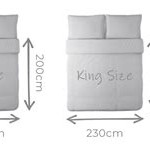Are White Bed Sheets a Bad Idea?
The crisp, clean aesthetic of white bed sheets has long been a symbol of luxury and tranquility in the bedroom. However, the practicality of maintaining pristine white bedding in the face of everyday life has led many to question whether this classic choice is truly a good idea. This article will explore the pros and cons of white bed sheets, examining factors such as cleanliness, aesthetics, and overall practicality.
Cleanliness: A Double-Edged Sword
White sheets offer an undeniable advantage when it comes to hygiene. Their bright hue makes even the smallest stains readily visible, encouraging frequent washing and preventing the buildup of dirt, dust mites, and other allergens. This high visibility can contribute to a healthier sleep environment, particularly for individuals with allergies or sensitivities. The ability to bleach white sheets is another significant benefit. Bleaching effectively removes stubborn stains and disinfects the fabric, ensuring a deeper level of clean than is possible with colored sheets, which can fade with bleach use.
However, this same visibility can also be a drawback. White sheets readily show every mark, from spilled coffee to makeup smudges, requiring more frequent laundering than darker-colored alternatives. This increased washing frequency can contribute to faster wear and tear on the fabric, potentially shortening the lifespan of the sheets. Furthermore, maintaining a truly pristine white can be challenging, requiring specific laundry detergents and techniques to prevent yellowing or graying over time.
Aesthetics: Timeless Elegance vs. High Maintenance
The undeniable appeal of white bedding lies in its timeless elegance. White creates a sense of airiness and spaciousness in the bedroom, contributing to a calming and serene atmosphere. It complements any decor style, from minimalist to traditional, and provides a neutral backdrop that allows other design elements to shine. White sheets can easily be paired with colorful throws, pillows, and blankets to create a variety of looks without clashing.
Maintaining this pristine aesthetic, however, requires considerable effort. As mentioned previously, white sheets are prone to showing every blemish, demanding meticulous care to prevent staining. This can create a sense of anxiety, particularly for households with children or pets. The pressure to maintain perfect whiteness can detract from the relaxing atmosphere that white bedding is intended to create.
Practicality: Cost vs. Longevity
While the initial cost of white sheets is often comparable to colored options, the long-term expenses can differ. The increased frequency of washing required for white sheets translates to higher water and energy bills over time. The need for specialized detergents and stain removers can further add to the expense. Additionally, the potential for faster wear and tear due to frequent washing may necessitate more frequent replacements, impacting overall cost-effectiveness.
Conversely, the ease with which white sheets can be bleached and disinfected can contribute to their longevity in terms of hygiene. Because they can be thoroughly cleaned and sanitized, white sheets can remain hygienically sound for an extended period, even with frequent use. This can be a significant advantage for individuals prioritizing a clean and healthy sleep environment.
Choosing the right bed sheet color ultimately comes down to individual priorities and lifestyle. While white sheets offer a classic, elegant look and promote a sense of cleanliness, they also require more maintenance and care. Weighing these factors carefully will help determine whether white bed sheets are a practical and suitable choice for your needs.
Psychological Impact: Tranquility vs. Anxiety
The color white is often associated with purity, calmness, and tranquility. In a bedroom setting, white sheets can contribute to a sense of peace and serenity, promoting relaxation and better sleep. The clean, uncluttered aesthetic can create a sense of order and simplicity, which can be particularly beneficial for individuals who feel overwhelmed by visual clutter.
However, the pressure to maintain pristine white sheets can also have the opposite effect, inducing anxiety and stress. The constant vigilance required to prevent stains and the fear of ruining the crisp white appearance can detract from the relaxing atmosphere and even interfere with sleep quality. For individuals prone to anxiety or perfectionism, the high-maintenance nature of white sheets might be a source of unnecessary stress.
Environmental Considerations: Washing and Wear
The frequent washing required to keep white sheets pristine can have environmental implications. Increased water and energy consumption contribute to a larger carbon footprint. Furthermore, the use of bleach, while effective for stain removal and disinfection, can be harmful to the environment if not used responsibly. Choosing eco-friendly detergents and laundry practices can mitigate some of these impacts but cannot entirely eliminate them.
The potential for faster wear and tear due to frequent washing can also contribute to textile waste. While higher-quality white sheets may be more durable, they are not immune to the effects of repeated laundering. Considering the lifespan and potential for recycling or repurposing when choosing white sheets can minimize environmental impact.

Are White Sheets A Bad Or Good Idea

Pros And Cons Of White Bedding Pottery Barn

Are White Sheets A Bad Or Good Idea

Why Is White Bedding The Most Popular Choice Of Vision Linens

Are White Sheets A Bad Or Good Idea

What Are The Best Colors For Bed Sheets

Are White Sheets A Bad Or Good Idea

Best Duvet Covers And Bedding Sets Tried Tested

Whitening Sheets Keep Your White Bed Parachute Blog

Top Sheet Vs No Let S Settle The Bedding Debate Saatva
Related Posts







